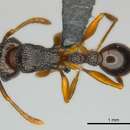en
names in breadcrumbs


Taxonomic history
Lectotype designation: Hita Garcia & Fisher, 2012b PDF: 26.Combination in Xiphomyrmex: Wheeler, 1922: 1031.Combination in Tetramorium: Bolton, 1979 PDF: 143.Status as species: Dalla Torre, 1893 PDF: 130; Wheeler, 1922: 1031; Emery, 1924f PDF: 287; Bolton, 1979 PDF: 143 (redescription); Bolton, 1995b: 404; Hita Garcia & Fisher, 2012b PDF: 26 (redescription).Senior synonym of Tetramorium robustior: Hita Garcia & Fisher, 2012b PDF.[[ worker ]]. L. environ 3,8 mill. Plus robuste et plus court que la forme typique. Le thorax est distinctement borde, avec un gros feston lateral au pronotum et un plus petit au mesonotum; ces caracteres sont encore plus distincts que chez le T. Steinheili. D'un noir a peine brunatre. Abdomen d'un brun noiratre. Pattes, antennes et mandibules rougeatres. Sculpture encore plus forte et plus grossiere que chez la forme typique du village de Nosibe aux confins de l'Imerina et des bords du Mangoro.
Foret d'Andrangoloaka.
(Fig. 14)
Tetramorium {Xiphomyrmex) andrei Forel , 1891 b: 263. Syntype workers, Madagascar: Bezanozano nr Nosibe, ESE. of Antananarivo (Sikora) (MHN, Geneva) [examined].
Worker . TL 4.3 - 4.8, HL 1.04 - 1.08, HW 0.92 - 0.96, CI 87 - 90, SL 0.80 - 0.84, SI 86 - 89, PW 0.70 - 0.72, AL 1.30 - 1.34 (6 measured).
Mandibles striate; median clypeal carina acute. Frontal carinae long and strong, diverging towards the occipital corners behind the level of the eyes but merging into the sculpture before reaching the occipital margin. Antennal scrobes a groove capable of containing the scape. Metanotal groove absent, not impressed in profile. Propodeal spines long and acute, the metapleural lobes short and triangular. Petiole node in profile longer than high, flat-topped or feebly convex dorsally, in dorsal view as long as or longer than broad. Dorsum of head regularly longitudinally rugose; dorsal alitrunk similarly sculptured but with some reticulation towards the sides on the pronotum. Petiole and postpetiole with rugose sculpture which is predominantly longitudinal. Gaster unsculptured except for pits from which hairs arise; these are more conspicuous in some specimens than in others. Dorsal surfaces of head and body all with numerous long, fine, erect to suberect hairs. Leading edges of antennal scape with suberect short, curved hairs. Colour light red-brown.
Of the tortuosum-group species on Madagascar andrei is most closely related to robustior , originally described as an infraspecific variant of andrei , and rather more distantly to latreillei and kelleri . Differences from robustior are listed under that species. T. andrei is distinguished easily from latreillei as the latter lacks hairs on the first gastral tergite and does not have standing hairs on the antennal scapes. T. kelleri , on the other hand, has abundant long hairs, the longest on the scapes being much greater than the maximum scapai width. Also, the node shape of the petiole is radically different, compare Figs 13 and 14.
Material examined
Madagascar: no loc. (Staudinger); no loc. (ex coll. Mayr); Ampasimbe, prov. Tamatave (J. M. Betsch).